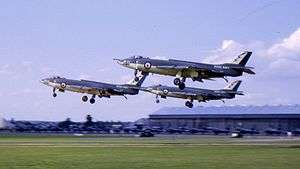736 Naval Air Squadron
| 736 Naval Air Squadron | |
|---|---|
|
Scimitars of 736 Squadron at Farnborough 1962 | |
| Active | 1943-1952, 1953-1965, 1966-1972, 2013-Present |
| Country | United Kingdom |
| Branch | Royal Navy |
| Type | Fleet Air Arm |
| Garrison/HQ | RNAS Culdrose |
| Aircraft | BAE Hawk T.1 |
| Commanders | |
| Lieutenant Commander | J.D. Baker |
| Aircraft flown | |
| Attack | Blackburn Buccaneer S.2 |
| Bomber | Fairey Barracuda |
| Fighter |
Supermarine Seafire Fairey Firefly Supermarine Attacker Supermarine Scimitar F.1 |
| Trainer | Gloster Meteor T.7 |
736 Naval Air Squadron (736 NAS) is a Naval Air Squadron of the Royal Navy. It was most recently recommissioned at RNAS Culdrose on 6 June 2013 to fly the BAE Systems Hawk T.1, following the disbandment of the Fleet Requirements and Aircraft Direction Unit (FRADU).[1]
History
Formation and early years
The squadron was first formed at RNAS Yeovilton on 24 May 1943 as an air combat training squadron for naval aviators, before moving to RNAS St Merryn in September that year. Between 1943 and 1952 the squadron operated several piston-engined aircraft including the Supermarine Seafire, Fairey Barracuda, Hawker Sea Fury and Fairey Firefly.[2]
The jet age
.jpg)
The squadron moved to RNAS Culdrose in 1950 where in August 1952, it was eventually disbanded as piston-engined squadron and reformed as the Advanced Jet Flying School; operating Supermarine Attacker and Meteor T.7 jet aircraft.
It was recommissioned at RNAS Lossiemouth in June 1953 as a training squadron for Sea Vampire and Hawker Sea Hawk. In 1959 the squadron was equipped with Supermarine Scimitar F.1 aircraft under the command of Lieutenant Commander J.D. Baker, to provide support for operational squadrons. As Scimitars started to be phased out of first line servicing, 736 Squadron was disbanded on 26 March 1965.
736 NAS reformed shortly afterwards with the Blackburn Buccaneer S.2, using aircraft and aircrews from the recently disbanded 700B Flight (the Buccaneer S.2 Intensive Flying Trials Unit) in order to train aircrews for the aircraft. Still based at RNAS Lossiemouth, from 1967 onwards the unit shared a pool of aircraft with 803 NAS, the Buccaneer HQ and weapons trials unit. With the decision to transfer all the RN's Buccaneers to the RAF, 736 NAS took on the extra task of training RAF crews. To cope with this, several Buccaneer S.1s were taken out of storage to increase the numbers of aircraft available, and a number of RAF aircrew who had previously served exchange tours with FAA Buccaneer squadrons were posted to 736 NAS as instructors. After a few accidents due to engine problems the S.1s were withdrawn from service in 1970. In 1971 the RAF stood up their own operational conversion unit (237 OCU) to take over the training of both their own and the dwindling number of RN aircrews.
736 NAS was finally disbanded in early 1972 until it was recommissioned in 2013. Now operating the Fleet Air Arm's BAe Hawk T1/T1A twin-seat fast-jet aircraft, the squadron has replaced the Fleet Requirements and Air Direction Unit (FRADU). Under the command of Lt Cdr Tim Flatman, the squadron is known as the Royal Navy 'Aggressor' squadron. During 2014 the squadrons aircraft began to be re-painted in its new markings and the first aircraft to receive the new look was XX240.
Since the squadron reformed it has taken part in various exercises including Joint Warrior, which is held in Scotland and 'Cougar 14' where a detachment of three aircraft operated in Albania.
References
- ↑ "Air branch reserve pilot clocks up 4000 hours". Royal Navy. Retrieved 14 June 2013.
- ↑ Mark, Russel. "http://www.fradu-hunters.co.uk/". Retrieved 14 June 2013. External link in
|title=(help)
